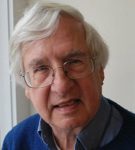 Throughout his 50-year career, Christopher Scholz, Professor of Earth and Environmental Sciences and of Applied Physics and Applied Mathematics at Columbia University and Lamont-Doherty Earth Observatory has brought a unique, interdisciplinary approach to seismology that bridges the gap from laboratory studies of rock mechanics to fundamental studies of crustal-scale deformation. His work on the brittle tectonics of the Earth’s crust has guided influential seismological research in areas such as the physics of earthquakes and the growth of faults and mountains.
Throughout his 50-year career, Christopher Scholz, Professor of Earth and Environmental Sciences and of Applied Physics and Applied Mathematics at Columbia University and Lamont-Doherty Earth Observatory has brought a unique, interdisciplinary approach to seismology that bridges the gap from laboratory studies of rock mechanics to fundamental studies of crustal-scale deformation. His work on the brittle tectonics of the Earth’s crust has guided influential seismological research in areas such as the physics of earthquakes and the growth of faults and mountains.
In his earliest research, Scholz was one of the first to show how rock deformation experiments in the lab could be related deformation in the crust. He soon applied his lab insights to illuminate patterns of strain accumulation and release in great subduction zone earthquakes. In the 1970s, Scholz proposed the dilatancy-diffusion model of earthquake prediction, which provided a framework for seismologists to study some of the geophysical effects in rock observed before and during an earthquake. His work has also helped to develop the methodology–used by the Southern California Earthquake Center and others to create regional seismic hazard maps–that extracts spatial and size distributions of earthquakes from geological observations of fault lengths and slip rates.
Scholz received his bachelor’s degree in geological engineering from the University of Nevada, Reno in 1964 and his Ph.D. from Massachusetts Institute of Technology in 1967. During his time at Columbia University and Lamont-Doherty, he has guided more than two dozen students to their doctoral degrees and to subsequent positions in universities and research laboratories. He has written more than 200 papers and books, including the 1990 acclaimed textbook, The Mechanics of Earthquakes and Faulting, with a second edition in 2003.
Scholz is a 2005 recipient of the prestigious Murchison Medal from the Geological Society of London, among his numerous other accolades. He has worked on active seismotectonic field sites in Iceland, Botswana, Malawi, Ethiopia, California, Iran, Japan, and New Zealand.
